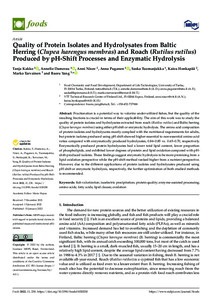Quality of Protein Isolates and Hydrolysates from Baltic Herring (Clupea harengus membras) and Roach (Rutilus rutilus) Produced by pH-Shift Processes and Enzymatic Hydrolysis
Tuomasjukka Saska; Nisov Anni; Tarvainen Marko; Puganen Anna; Honkapää Kaisu; Yang Baoru; Kakko Tanja; Damerau Annelie
Quality of Protein Isolates and Hydrolysates from Baltic Herring (Clupea harengus membras) and Roach (Rutilus rutilus) Produced by pH-Shift Processes and Enzymatic Hydrolysis
Tuomasjukka Saska
Nisov Anni
Tarvainen Marko
Puganen Anna
Honkapää Kaisu
Yang Baoru
Kakko Tanja
Damerau Annelie
MDPI
Julkaisun pysyvä osoite on:
https://urn.fi/URN:NBN:fi-fe2022081155041
https://urn.fi/URN:NBN:fi-fe2022081155041
Tiivistelmä
Fractionation is a potential way to valorize under-utilized fishes, but the quality of the resulting fractions is crucial in terms of their applicability. The aim of this work was to study the quality of protein isolates and hydrolysates extracted from roach (Rutilus rutilus) and Baltic herring (Clupea harengus membras) using either pH shift or enzymatic hydrolysis. The amino acid composition of protein isolates and hydrolysates mostly complied with the nutritional requirements for adults, but protein isolates produced using pH shift showed higher essential to non-essential amino acid ratios compared with enzymatically produced hydrolysates, 0.84-0.85 vs. 0.65-0.70, respectively. Enzymatically produced protein hydrolysates had a lower total lipid content, lower proportion of phospholipids, and exhibited lower degrees of protein and lipid oxidation compared with pH-shift-produced isolates. These findings suggest enzymatic hydrolysis to be more promising from a lipid oxidation perspective while the pH-shift method ranked higher from a nutrient perspective. However, due to the different applications of protein isolates and hydrolysates produced using pH shift or enzymatic hydrolysis, respectively, the further optimization of both studied methods is recommended.
Kokoelmat
- Rinnakkaistallenteet [19207]
